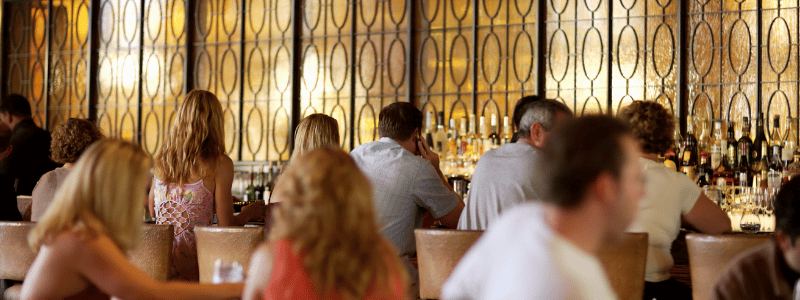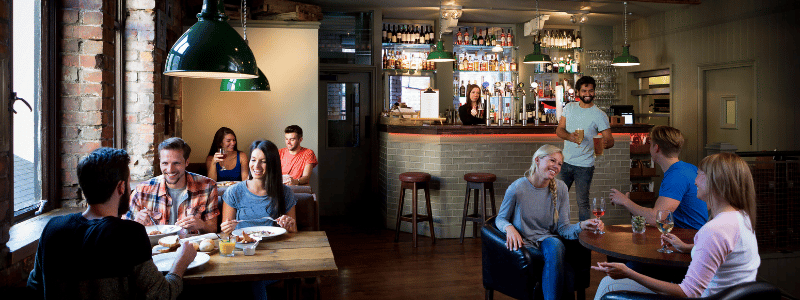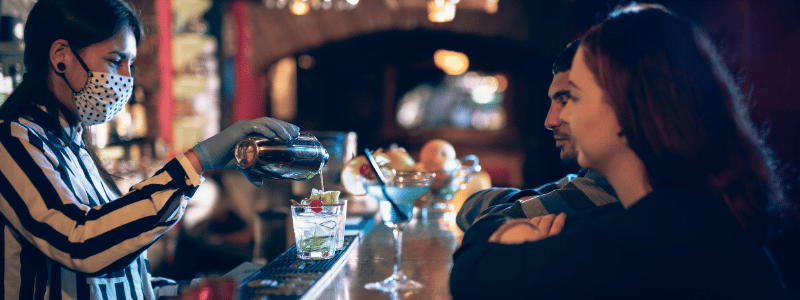During Covid-19, occupancy levels were drastically reduced and customers rarely had to wait for orders at bars. Considering historic average wait times for a drink, it’s difficult to gauge where bars and breweries will be in a post-Covid world. A study conducted by Tails Cocktails back in 2019 showed that bartenders blamed premium cocktails for slowing down order fulfillment. In fact, 85% of bartenders polled said complicated ingredients bog down the process – even if premium spirits yield a better return. As we start to return to some normalcy (and as the occupancy restrictions are lifted), it’s a great time to optimize your bar’s business for efficiency.
Customers returning to the bars may or may not remember the common wait times for drink orders. And, certainly, with the lower occupancy levels, your bar staff likely isn’t conditioned for higher volumes. Think your bartenders were in the weeds before Covid? Consider how bad it might be if they’re rusty when the crowds return!
So, let’s take a look at the problem of bar efficiency and review the bottlenecks; perhaps we can identify some areas of opportunity.

How long should a customer wait for a drink?
When you order a beer, the bartender just uncaps a bottle and slides it over. Wait time? Less than a minute. However, more complicated cocktails and orders with a variety of drinks can drastically increase the time it takes to create and deliver the order. On average – regardless of order size and complexity – a bar transaction takes 4.3 minutes from the time that the customer places the order to the time the bartender can take the next order. However, if you’re the customer whose friends are waiting on you to get the next round, or perhaps your date is waiting, that 4.3 minutes can feel like an eternity. And, considering that average factors in small, neighborhood bars with only a couple of customers, if you visit any high-volume establishment, you might find yourself waiting 10-15 minutes. It all depends on the bar’s staffing, organization, inventory, and crowd size.
It’s interesting, really, that busy bars attract more people. People want to be where people are. If you’re at a theme park and you see a line for a particular ride, you might reconsider if you really want to wait in line. But, for bars, a line conveys a sense of desirability – you want to be where others want to be, even if you have to wait in line. But that inherently means that service will be slower. And, with larger crowds and higher order volumes comes a greater risk of dropped drinks, mis-prepared drinks, and a variety of other hiccups that can occur during stressful times.
Transformations with COVID-19
Now consider this… COVID-19 eliminated crowds, so wait times were non-existent. Now that people are coming out of their caves, are they willing to wait as they did before the pandemic?
COVID-19 changed a lot of things, many of which will not return to normal. With many companies opting for remote-work options, gone are the days when people were required to go to an office to work. So, will customers return to bars that have long waits? Or will they opt to stay home as they did during COVID-19?
Brandon, a bar owner in Ft. Lauderdale, Florida, has noticed a difference in customers’ behavior. “They’re not as patient as before,” he says, referring to his bar’s clientele. “I see patrons leaving the bar because of the waiting time more readily, more frequently.” Mike, a bar owner in Chicago, decided to downsize his offerings, opting to focus on simple options. “When drink orders have too many different drinks, or have drinks involving multiple ingredients, the order just takes longer than customers are willing to wait,” he says. “It sucks because I loved our menu before Covid, but we just can’t offer what we want to offer until people get used to crowds again.”
So, how do customers get served more effectively?
Learning the best practices to improve average wait times for drinks can certainly help bars, breweries, wineries, and distilleries recover much sooner. The best practices can help get served more quickly than expected. Placing orders for drinks can be stressful at the bar. Let’s take a look at some key tips you should follow for getting served at the bar.

1. Show you’re available
When you step into a bar, no one cares about you (except your friends or the ones who stare at you). If you want to be served quickly, make sure to enter into a face-to-face encounter with the bartender. Remember, gazing off into a distance would not help you. For that reason, make sure to be available for bartenders rather than standing with your back to the bar.
2. Show the money
In a busy bar with hovering drinkers, you need to appear yourselves to be the most “available”, but it is not enough to make sure you will get served quickly. This is where displaying your money for the order is the best way to show you are not available but ready to pay for your drink as well. It can make you an attractive choice in a crowded place of potential next customers.
3. Avoid using unnecessary abbreviations
Sometimes, customers want to be cool and abbreviate things. However, it is not the right way to order a drink at a busy bar. Therefore, make sure to avoid using unnecessary abbreviations when ordering a drink. Doing so can make the bartender confused or you may end up ordering something else.
“People usually abbreviate things while ordering their drinks, like asking for ‘Pinot’ and it could mean Pinot Grigio or Pinot Noir. It becomes hard to understand when there is a sea of potential customers shouting in front of you,” said Greg at one of Chicago’s busiest bars.

Common Mistakes to Avoid that Cause Longer Waits in Bars
Increased average wait times for drinks can result in a sale loss. Consider patrons who may grow tired of long waits at bars? There are some causes of longer waits that you should avoid, such as:
Determine what to order before you even approach the bar
There is nothing wrong with asking the bartender about the drink menu, but it can result in a longer wait time. For that reason, it is recommended to be prepared beforehand and make sure to at least have an idea of what you want to drink. It is not possible to have an efficient conversation with a bartender in a busy bar. Bartenders tend to help other customers as well. It is a decent thing to know what you want to order before you approach a bar.
Avoid ordering hot drinks during peak bar hours
It is always time-consuming to make hot drinks. In fact, if you’re curious, read the list of drinks you should avoid altogether from bars from Insider here. If you wish to be at the bar during peak hours, you may want to avoid ordering work-intensive beverages. Even if you order one, there are chances that you might not receive the expected version of the drink. Additionally, it will take longer for you to get it.
Avoid ordering hot cocktails when a bar is incredibly busy. Such a drink requires more effort as compared to one that’s served on ice. As a result, it will take a while for you to get your drink at the bar.
Gloworder: Improving Average Wait Times for Drinks
Certainly, the pandemic impacted bars in numerous ways. It also brought a long-standing issue to light that technology seems uniquely capable of addressing. Improving average wait times for drinks seems like a no-brainer, but surprisingly it’s a characteristic that bars have been slow to adopt. Gloworder addresses this from two perspectives: wait times in consideration of the bar patron and wait times for bartenders desperate to turnover more tabs, especially when a busy night yields higher return. Bar owners: want to learn more?
Sign up on our waitlist to find out more about our upcoming Gloworder app launch!
